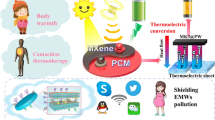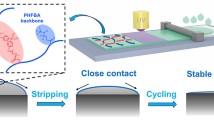Abstract
As a newly discovered two-dimensional (2D) material, MXene has attracted much attention because of its fascinating physicochemical properties. However, the issue of agglomeration has limited its application in anti-corrosive polymeric coatings. Herein, a novel nanofiller, phosphoric acid-modified chitosan (mCS)-functionalized MXene (fMX), has been successfully constructed and used to endow waterborne epoxy (WEP) coatings with brilliant corrosive resistance. Electrochemical results demonstrate that the |Z0.01 Hz| value for 0.2 wt% fMX/WEP composite coating (4.73 × 107 Ω cm2) is more than two orders of magnitude higher than that of the blank WEP (2.09 × 105 Ω cm2) and the corrosion current density value of 0.2 wt% fMX/WEP maintains above 5.44 × 10−9 A/cm2 after soaking in 3.5 wt% NaCl solution for 50 days. It is nearly two orders lower than that of blank WEP (5.23 × 10−7 A/cm2). Thus, this novel mCS-functionalized MXene can serve as an effective composite nanofiller for preparing MXene-based high-performance anti-corrosive coatings.
Graphical abstract
Phosphorylated chitosan-functionalized MXene (fMX)-based polymeric composite coatings have excellent long-term anti-corrosive property.












Similar content being viewed by others
References
Huang H, Tian Y, Xie Y et al (2020) Modification of graphene oxide with acrylate phosphorus monomer via thiol-Michael addition click reaction to enhance the anti-corrosive performance of waterborne epoxy coatings. Prog Org Coat 146:105724. https://doi.org/10.1016/j.porgcoat.2020.105724
Andreeva DV, Skorb EV, Shchukin DG (2010) Layer-by-layer polyelectrolyte/inhibitor nanostructures for metal corrosion protection. ACS Appl Mater Interfaces 2:1954–1962. https://doi.org/10.1021/am1002712
Lin J, Hu J, Wang W et al (2021) Thermo and light-responsive strategies of smart titanium-containing composite material surface for enhancing bacterially anti-adhesive property. Chem Eng J 407:125783. https://doi.org/10.1016/j.cej.2020.125783
Zhu Q, Huang Y, Li Y et al (2021) Aluminum dihydric tripolyphosphate/polypyrrole-functionalized graphene oxide waterborne epoxy composite coatings for impermeability and corrosion protection performance of metals. Adv Compos Hybrid Mater 4:780–792. https://doi.org/10.1007/s42114-021-00265-6
Yang X, Zhong X, Zhang J, Gu J (2021) Intrinsic high thermal conductive liquid crystal epoxy film simultaneously combining with excellent intrinsic self-healing performance. J Mater Sci Technol 68:209–215. https://doi.org/10.1016/j.jmst.2020.08.027
Madhusudhana AM, Mohana KNS, Hegde MB et al (2020) Functionalized graphene oxide-epoxy phenolic novolac nanocomposite: an efficient anticorrosion coating on mild steel in saline medium. Adv Compos Hybrid Mater 3:141–155. https://doi.org/10.1007/s42114-020-00142-8
Hu J, Lin J, Zhang Y et al (2019) A new anti-biofilm strategy of enabling arbitrary surfaces of materials and devices with robust bacterial anti-adhesion via a spraying modified microsphere method. J Mater Chem A 7:26039–26052. https://doi.org/10.1039/C9TA07236E
Xia Y, Zhang N, Zhou Z et al (2020) Incorporating SiO2 functionalized g-C3N4 sheets to enhance anticorrosion performance of waterborne epoxy. Prog Org Coat 147:105768. https://doi.org/10.1016/j.porgcoat.2020.105768
Yang X, Liang C, Ma T et al (2018) A review on thermally conductive polymeric composites: classification, measurement, model and equations, mechanism and fabrication methods. Adv Compos Hybrid Mater 1:207–230. https://doi.org/10.1007/s42114-018-0031-8
Liang C, Song P, Qiu H et al (2019) Constructing interconnected spherical hollow conductive networks in silver platelets/reduced graphene oxide foam/epoxy nanocomposites for superior electromagnetic interference shielding effectiveness. Nanoscale 11:22590–22598. https://doi.org/10.1039/C9NR06022G
Ma Y, Huang H, Zhou H et al (2021) Superior anti-corrosion and self-healing bi-functional polymer composite coatings with polydopamine modified mesoporous silica/graphene oxide. J Mater Sci Technol 95:95–104. https://doi.org/10.1016/j.jmst.2021.04.019
Yan H, Dai X, Ruan K et al (2021) Flexible thermally conductive and electrically insulating silicone rubber composite films with BNNS@Al2O3 fillers. Adv Compos Hybrid Mater 4:36–50. https://doi.org/10.1007/s42114-021-00208-1
Song P, Liu B, Qiu H et al (2021) MXenes for polymer matrix electromagnetic interference shielding composites: a review. Compos Commun 24:100653. https://doi.org/10.1016/j.coco.2021.100653
Zhang Y, Ruan K, Gu J (2021) Flexible sandwich-structured electromagnetic interference shielding nanocomposite films with excellent thermal conductivities. Small. https://doi.org/10.1002/smll.202101951
Qi F, Wang L, Zhang Y et al (2021) Robust Ti3C2Tx MXene/starch derived carbon foam composites for superior EMI shielding and thermal insulation. Mater Today Phys. https://doi.org/10.1016/j.mtphys.2021.100512
Yang X, Fan S, Li Y et al (2020) Synchronously improved electromagnetic interference shielding and thermal conductivity for epoxy nanocomposites by constructing 3D copper nanowires/thermally annealed graphene aerogel framework. Compos Part Appl Sci Manuf 128:105670. https://doi.org/10.1016/j.compositesa.2019.105670
Liang C, Qiu H, Song P et al (2020) Ultra-light MXene aerogel/wood-derived porous carbon composites with wall-like “mortar/brick” structures for electromagnetic interference shielding. Sci Bull 65:616–622. https://doi.org/10.1016/j.scib.2020.02.009
Yan H, Cai M, Li W et al (2020) Amino-functionalized Ti3C2T with anti-corrosive/wear function for waterborne epoxy coating. J Mater Sci Technol 54:144–159. https://doi.org/10.1016/j.jmst.2020.05.002
Sun W, Wang L, Wu T et al (2015) Inhibiting the corrosion-promotion activity of graphene. Chem Mater 27:2367–2373. https://doi.org/10.1021/cm5043099
Cui M, Ren S, Pu J et al (2019) Poly(o-phenylenediamine) modified graphene toward the reinforcement in corrosion protection of epoxy coatings. Corros Sci 159:108131. https://doi.org/10.1016/j.corsci.2019.108131
Cai M, Yan H, Li Y et al (2021) Ti3C2Tx/PANI composites with tunable conductivity towards anticorrosion application. Chem Eng J 410:128310. https://doi.org/10.1016/j.cej.2020.128310
Cui G, Guo J, Zhang Y et al (2019) Chitosan oligosaccharide derivatives as green corrosion inhibitors for P110 steel in a carbon-dioxide-saturated chloride solution. Carbohydr Polym 203:386–395. https://doi.org/10.1016/j.carbpol.2018.09.038
Cheng S, Chen S, Liu T et al (2007) Carboxymenthylchitosan as an ecofriendly inhibitor for mild steel in 1 M HCl. Mater Lett 61:3276–3280. https://doi.org/10.1016/j.matlet.2006.11.102
Fayyad EM, Sadasivuni KK, Ponnamma D, Al-Maadeed MAA (2016) Oleic acid-grafted chitosan/graphene oxide composite coating for corrosion protection of carbon steel. Carbohydr Polym 151:871–878. https://doi.org/10.1016/j.carbpol.2016.06.001
Ruhi G, Modi OP, Dhawan SK (2015) Chitosan-polypyrrole-SiO2 composite coatings with advanced anticorrosive properties. Synth Met 200:24–39. https://doi.org/10.1016/j.synthmet.2014.12.019
Abd El-Fattah M, El-Saeed AM, Azzam AM et al (2016) Improvement of corrosion resistance, antimicrobial activity, mechanical and chemical properties of epoxy coating by loading chitosan as a natural renewable resource. Prog Org Coat 101:288–296. https://doi.org/10.1016/j.porgcoat.2016.09.002
Jayakumar R, Nagahama H, Furuike T, Tamura H (2008) Synthesis of phosphorylated chitosan by novel method and its characterization. Int J Biol Macromol 42:335–339. https://doi.org/10.1016/j.ijbiomac.2007.12.011
Yu H, Xu X, Xia Y et al (2020) Synthesis of a novel modified chitosan as an intumescent flame retardant for epoxy resin. E-Polym 20:303–316. https://doi.org/10.1515/epoly-2020-0036
Zheng B, Mao C, Gu T et al (2019) Phosphorylated chitosan to promote biomimetic mineralization of type I collagen as a strategy for dentin repair and bone tissue engineering. New J Chem 43:2002–2010. https://doi.org/10.1039/C8NJ04889D
Lu X, Huang H, Zhang X et al (2019) Novel light-driven and electro-driven polyethylene glycol/two-dimensional MXene form-stable phase change material with enhanced thermal conductivity and electrical conductivity for thermal energy storage. Compos Part B Eng 177:107372. https://doi.org/10.1016/j.compositesb.2019.107372
Zhou Y, Lin Y, Tawiah B et al (2021) DOPO-decorated two-dimensional MXene nanosheets for flame-retardant, ultraviolet-protective, and reinforced polylactide composites. ACS Appl Mater Interfaces 13:21876–21887. https://doi.org/10.1021/acsami.1c05587
Wei Y, Luo W, Zhuang Z et al (2021) Fabrication of ternary MXene/MnO2/polyaniline nanostructure with good electrochemical performances. Adv Compos Hybrid Mater. https://doi.org/10.1007/s42114-021-00323-z
Sheng X, Zhao Y, Zhang L, Lu X (2019) Properties of two-dimensional Ti3C2 MXene/thermoplastic polyurethane nanocomposites with effective reinforcement via melt blending. Compos Sci Technol 181:107710. https://doi.org/10.1016/j.compscitech.2019.107710
Osti NC, Naguib M, Ostadhossein A et al (2016) Effect of metal ion intercalation on the structure of MXene and water dynamics on its internal surfaces. ACS Appl Mater Interfaces 8:8859–8863. https://doi.org/10.1021/acsami.6b01490
Yazdanparast S, Soltanmohammad S, Fash-White A et al (2020) Synthesis and surface chemistry of 2D TiVC solid-solution MXenes. ACS Appl Mater Interfaces 12:20129–20137. https://doi.org/10.1021/acsami.0c03181
Ungár T (2004) Microstructural parameters from X-ray diffraction peak broadening. Scr Mater 51:777–781. https://doi.org/10.1016/j.scriptamat.2004.05.007
Amaral IF, Granja PL, Barbosa MA (2005) Chemical modification of chitosan by phosphorylation: an XPS, FT-IR and SEM study. J Biomater Sci Polym Ed 16:1575–1593. https://doi.org/10.1163/156856205774576736
Wang Y, Liu Z, Wei X et al (2021) An integrated strategy for achieving oil-in-water separation, removal, and anti-oil/dye/bacteria-fouling. Chem Eng J 413:127493. https://doi.org/10.1016/j.cej.2020.127493
Chen C-H, Wang F-Y, Mao C-F et al (2008) Studies of chitosan: II. Preparation and characterization of chitosan/poly(vinyl alcohol)/gelatin ternary blend films. Int J Biol Macromol 43:37–42. https://doi.org/10.1016/j.ijbiomac.2007.09.005
Halim J, Cook KM, Naguib M et al (2016) X-ray photoelectron spectroscopy of select multi-layered transition metal carbides (MXenes). Appl Surf Sci 362:406–417. https://doi.org/10.1016/j.apsusc.2015.11.089
Raj KJA, Shanmugam R, Mahalakshmi R, Viswanathan B (2010) XPS and IR spectral studies on the structure of phosphate and sulphate modified titania – a combined DFT and experimental study. IJC- Vol49A01 January 2010
Gao Q, Pan Y, Zheng G et al (2021) Flexible multilayered MXene/thermoplastic polyurethane films with excellent electromagnetic interference shielding, thermal conductivity, and management performances. Adv Compos Hybrid Mater 4:274–285. https://doi.org/10.1007/s42114-021-00221-4
Liu X, Guo J, Tang W et al (2019) Enhancing the flame retardancy of thermoplastic polyurethane by introducing montmorillonite nanosheets modified with phosphorylated chitosan. Compos Part Appl Sci Manuf 119:291–298. https://doi.org/10.1016/j.compositesa.2019.02.009
Maleski K, Mochalin VN, Gogotsi Y (2017) Dispersions of two-dimensional titanium carbide MXene in organic solvents. Chem Mater 29:1632–1640. https://doi.org/10.1021/acs.chemmater.6b04830
Zhou X, Huang H, Zhu R et al (2019) Facile modification of graphene oxide with lysine for improving anti-corrosion performances of water-borne epoxy coatings. Prog Org Coat 136:105200. https://doi.org/10.1016/j.porgcoat.2019.06.046
Tikhani F, Jouyandeh M, Jafari SH et al (2019) Cure index demonstrates curing of epoxy composites containing silica nanoparticles of variable morphology and porosity. Prog Org Coat 135:176–184. https://doi.org/10.1016/j.porgcoat.2019.05.017
Zhang L, Li CZ, Zhou Q, Shao W (2007) Aluminum hydroxide filled ethylene vinyl acetate (EVA) composites: effect of the interfacial compatibilizer and the particle size. J Mater Sci 42:4227–4232. https://doi.org/10.1007/s10853-006-0630-6
Sheng X, Mo R, Ma Y et al (2019) Waterborne epoxy resin/polydopamine modified zirconium phosphate nanocomposite for anticorrosive coating. Ind Eng Chem Res 58:16571–16580. https://doi.org/10.1021/acs.iecr.9b02557
Zheng S, Bellido-Aguilar DA, Hu J et al (2019) Waterborne bio-based epoxy coatings for the corrosion protection of metallic substrates. Prog Org Coat 136:105265. https://doi.org/10.1016/j.porgcoat.2019.105265
Bonora PL, Deflorian F, Fedrizzi L (1996) Electrochemical impedance spectroscopy as a tool for investigating underpaint corrosion. Electrochim Acta 41:1073–1082. https://doi.org/10.1016/0013-4686(95)00440-8
Mahdavian M, Attar MM (2009) Electrochemical behaviour of some transition metal acetylacetonate complexes as corrosion inhibitors for mild steel. Corros Sci 51:409–414. https://doi.org/10.1016/j.corsci.2008.11.010
Hamdy AS, Doench I, Möhwald H (2011) Smart self-healing anti-corrosion vanadia coating for magnesium alloys. Prog Org Coat 72:387–393. https://doi.org/10.1016/j.porgcoat.2011.05.011
Li Z, Qin B, Zhang X et al (2015) Self-healing anti-corrosion coatings based on polymers of intrinsic microporosity for the protection of aluminum alloy. RSC Adv 5:104451–104457. https://doi.org/10.1039/C5RA19614K
Wang N, Zhang Y, Chen J et al (2017) Dopamine modified metal-organic frameworks on anti-corrosion properties of waterborne epoxy coatings. Prog Org Coat 109:126–134. https://doi.org/10.1016/j.porgcoat.2017.04.024
Huang H, Li M, Tian Y et al (2020) Exfoliation and functionalization of α-zirconium phosphate in one pot for waterborne epoxy coatings with enhanced anticorrosion performance. Prog Org Coat 138:105390. https://doi.org/10.1016/j.porgcoat.2019.105390
Coquery C, Negrell C, Caussé N et al (2019) Synthesis of new high molecular weight phosphorylated chitosans for improving corrosion protection. Pure Appl Chem 91:509–521. https://doi.org/10.1515/pac-2018-0509
Soleymanibrojeni M, Shi H, Udoh II et al (2019) Microcontainers with 3-amino-1,2,4-triazole-5-thiol for enhancing anticorrosion waterborne coatings for AA2024-T3. Prog Org Coat 137:105336. https://doi.org/10.1016/j.porgcoat.2019.105336
Hayatgheib Y, Ramezanzadeh B, Kardar P, Mahdavian M (2018) A comparative study on fabrication of a highly effective corrosion protective system based on graphene oxide-polyaniline nanofibers/epoxy composite. Corros Sci 133:358–373. https://doi.org/10.1016/j.corsci.2018.01.046
Cui M, Ren S, Qin S et al (2018) Processable poly(2-butylaniline)/hexagonal boron nitride nanohybrids for synergetic anticorrosive reinforcement of epoxy coating. Corros Sci 131:187–198. https://doi.org/10.1016/j.corsci.2017.11.022
Funding
This work was supported by the National Natural Science Foundation of China (Grant Nos. 51908031 and 52003111). X. S. acknowledges the support from the Research Fund Program of Guangdong Provincial Key Lab of Green Chemical Product Technology (Grant No. GC202110). Y. C. acknowledges the support from Guangdong Special Support Program (Grant No. 2017TX04N371). J. H. acknowledges the support from the Opening Project of Key Laboratory of Polymer Processing Engineering (South China University of Technology), Ministry of Education (Grant No. KFKT2001).
Author information
Authors and Affiliations
Corresponding authors
Ethics declarations
Conflict of interest
The authors declare no competing interests.
Additional information
Publisher's Note
Springer Nature remains neutral with regard to jurisdictional claims in published maps and institutional affiliations.
Supplementary Information
Below is the link to the electronic supplementary material.
Rights and permissions
About this article
Cite this article
He, X., Li, S., Shen, R. et al. A high-performance waterborne polymeric composite coating with long-term anti-corrosive property based on phosphorylation of chitosan-functionalized Ti3C2Tx MXene. Adv Compos Hybrid Mater 5, 1699–1711 (2022). https://doi.org/10.1007/s42114-021-00392-0
Received:
Revised:
Accepted:
Published:
Issue Date:
DOI: https://doi.org/10.1007/s42114-021-00392-0




